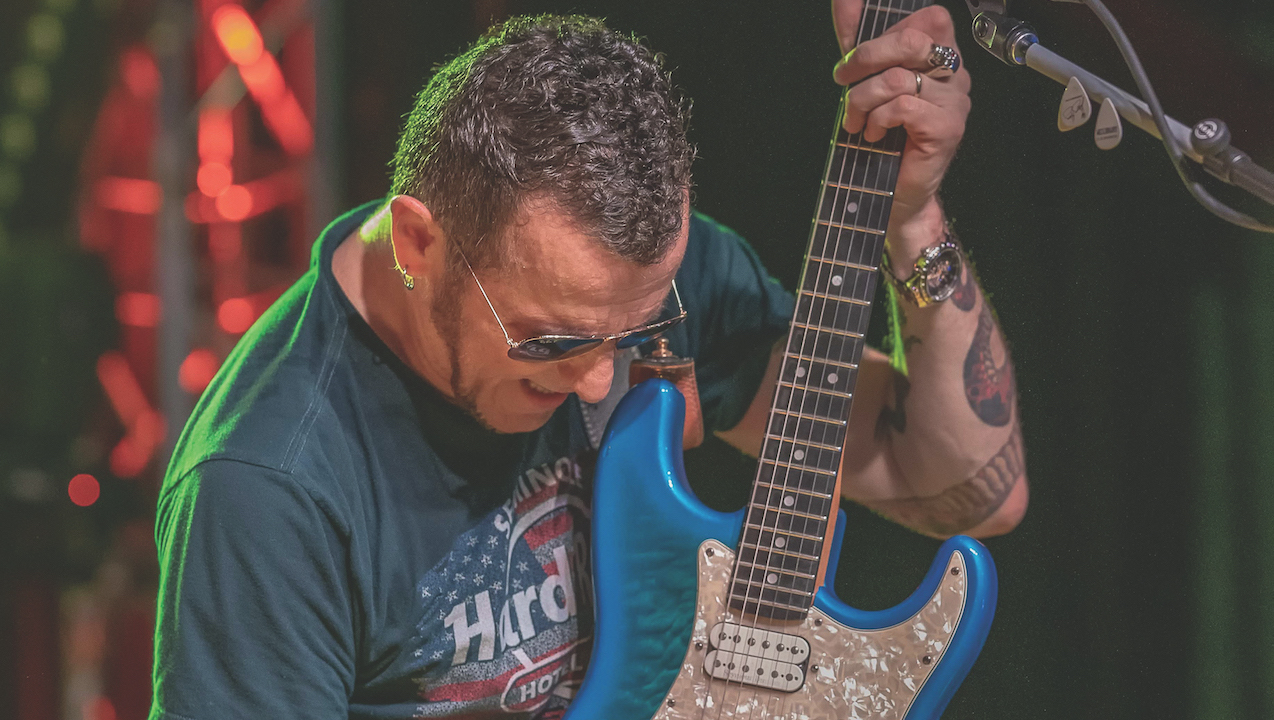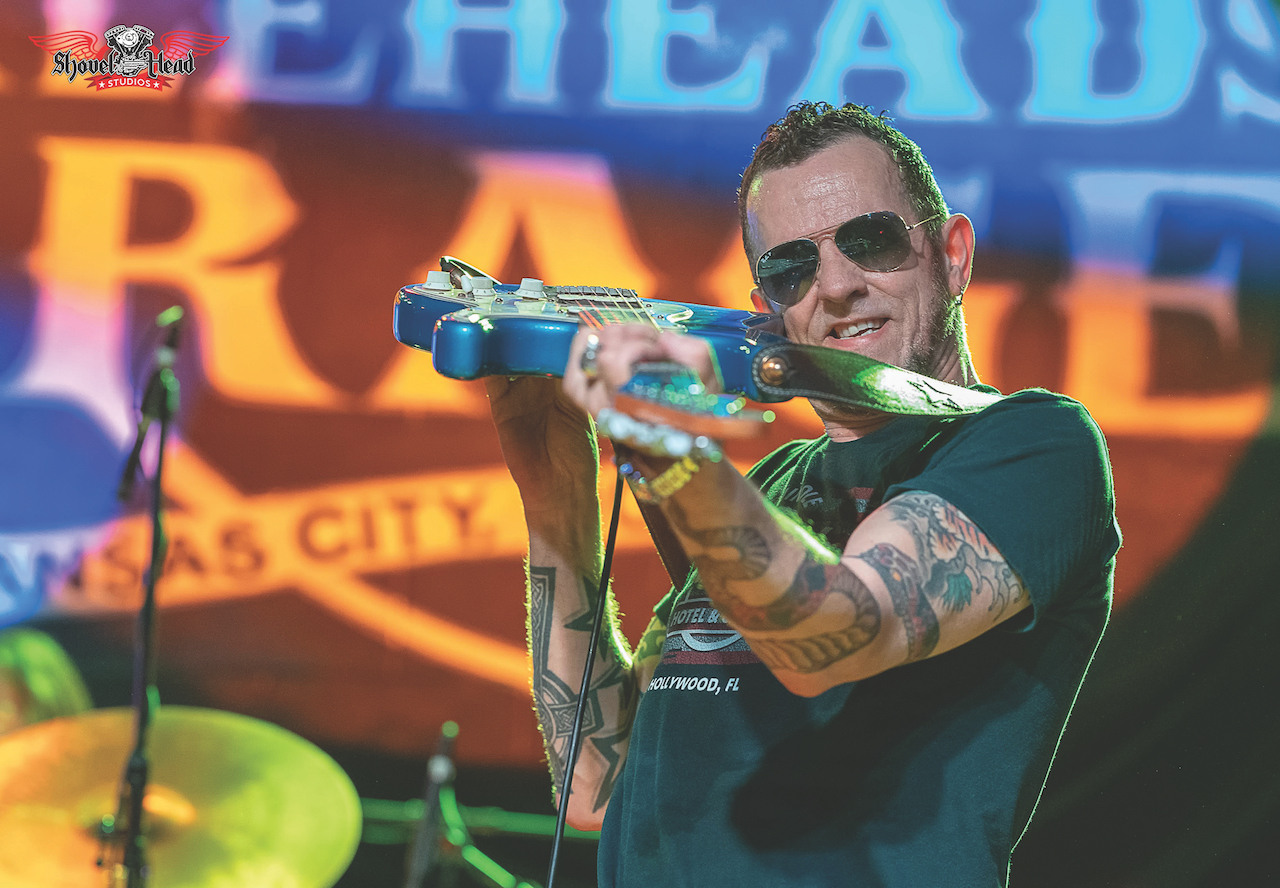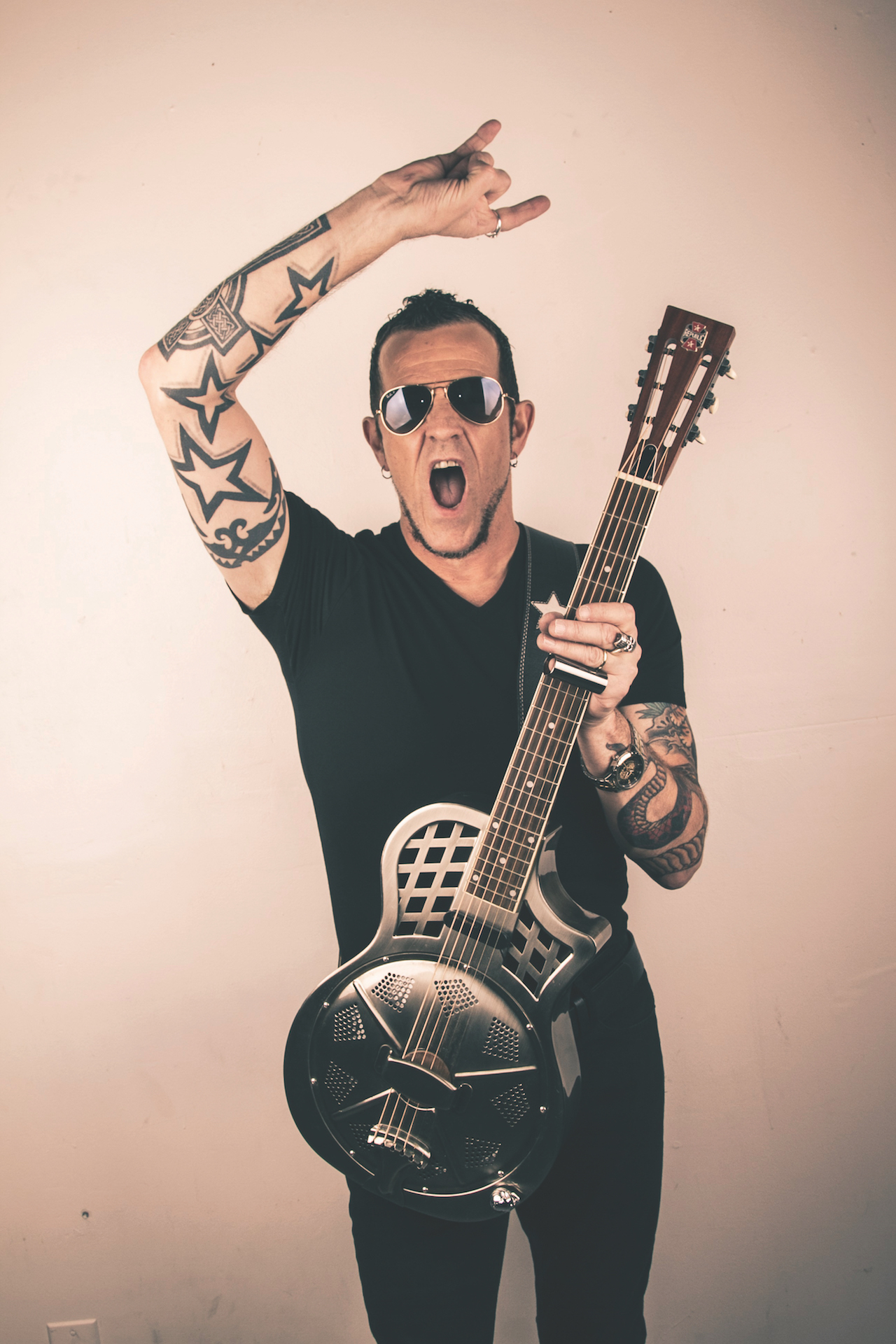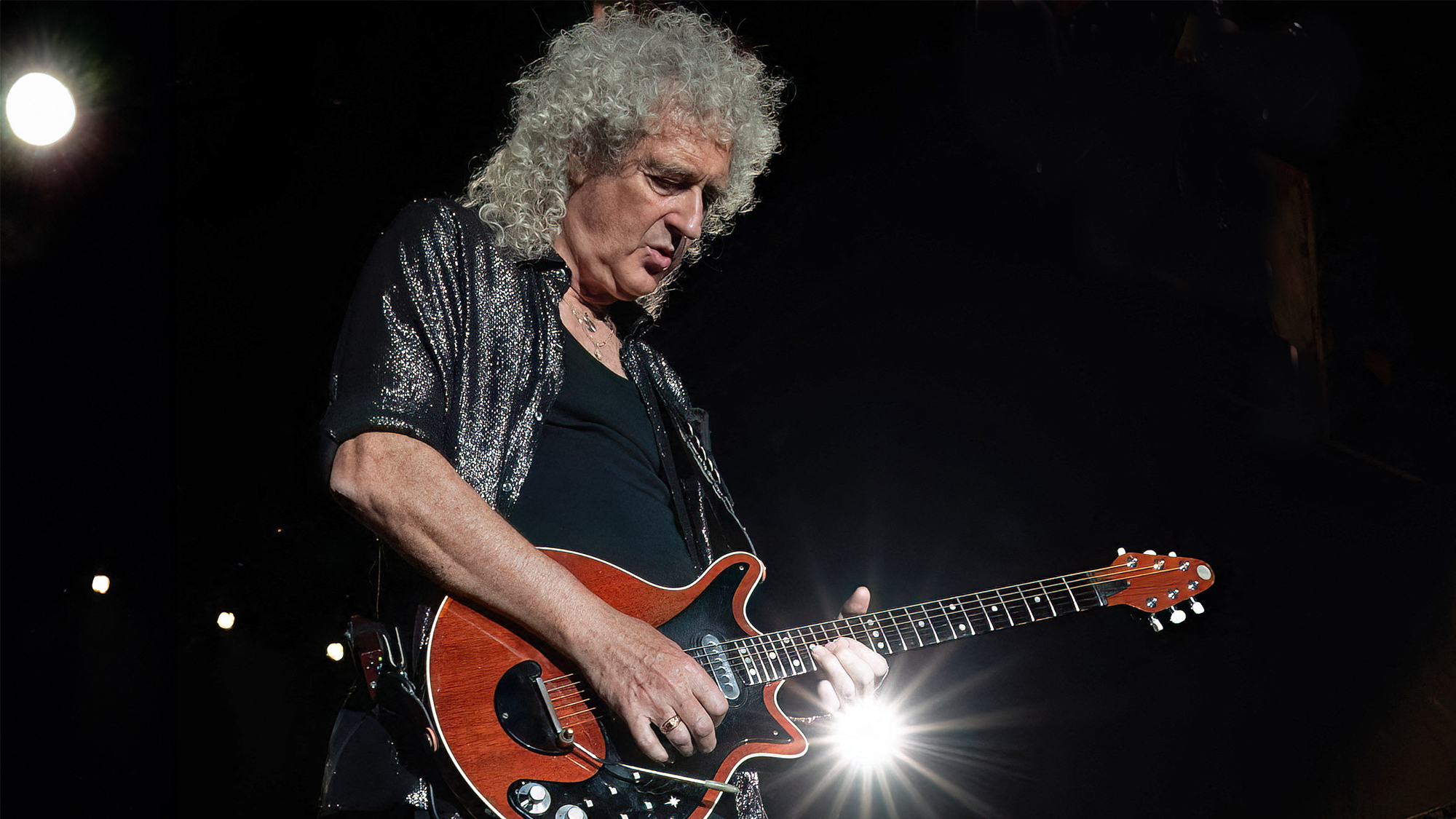
In addition to his solo career, Gary Hoey has recorded and/or toured with some of the biggest electric guitarists around — players like Brian May, Joe Satriani, Eric Johnson, Peter Frampton, Rick Derringer and Kenny Wayne Shepherd, among others. He explains that with each pairing, he keeps his eyes and ears open for any playing tips he might pick up, and he’ll seek advice whenever possible.
“I’m a fan of these players, just like anybody else,” Hoey says. “I’m always trying to incorporate the things they can do into my style. I did a Rock and Roll Fantasy Camp with Steve Morse, and I picked up some cool pointers from him.”
One such technique involved fingerstyle playing with your picking hand. “Steve talked about how a lot of players don’t use their fingers while they’re using their picks,” Hoey says. “Their fingers just hang there while their pick does all the work. You can add all kinds of licks if you work your fingers into the mix. Even if you’re strumming chords, you can grab the strings with your third, fourth and pinkie fingers. It’s kind of like how a piano player can get multiple notes all at once. I’ve been doing that now, and it’s really cool.”
Of course, Hoey has his own tips for electric guitar players who want to up their game, and he took the time to share them with us. Try these for yourself!
LEARN YOUR NECK
“I’m always surprised to see how a lot of players don’t learn the neck of their guitar. They kind of play blindly, but they really haven’t taken the time to know where they’re going. They’re probably thinking, How come I can’t play the right note at the right time? The answer is simple: Because they don’t know what the right note is.
“I started by telling my students to look at the first part of the neck, where there are four dots. Now look at the part of the neck after the 12th fret — there are four dots there too. You’ve got your big neck and your little neck. Anything you can play on those first four dots can also be played on the little part of the neck starting with the 12th fret. Train yourself to slide up there an octave higher and try it. This can really make your solos more interesting and exciting.
“Remember, there are only 12 notes. If you learn a C major scale like you would on a piano, you’ve already learned three-quarters of every note on the neck.”
All the latest guitar news, interviews, lessons, reviews, deals and more, direct to your inbox!
PRACTICE BENDS WITH YOUR TUNER
“I’ll hear a guitarist play, and he’s nailing all the right notes, but quite often I notice that his bends are out of tune. This is what separates the pros from the Joes. It’s like when you hear certain singers and you think they’re great, but then they hit a note a little flat or sharp.
“I tell people to make sure they’re in tune when they practice. The best way is to use a clip-on tuner and play a bend: Try to bend up a whole step without looking at the tuner. Once you think you’ve done it, look at the tuner and see if you’re in tune. I started doing this and I found that I was flat quite often. To fix that problem, I decided to bend a little higher and use my ear. After a while, I noticed on my tuner that I was right on the money. You can do this with anything you play — it doesn’t have to be a bend. After a while, you can train your fingers and your ears to know when you’re playing in tune."

DO THE "TRILL DRILL"
“I have this little exercise called the ‘trill drill.’ I’ll play a 16th-note trill on the B string using my first and second fingers on the fifth and sixth frets. After a few measures, I’ll switch to the first and third fingers on the fifth and seventh frets. Then I’ll do the first finger and my pinkie on the fifth and eighth frets. Try it. You’ll feel a little burn, but it’ll really develop your hammer-ons and pull-offs.
“You can get fancy and vary it. Try the second and third fingers, and then the second and fourth. Finally, try the third and fourth fingers. You can go through all the different combinations and have a good time with them. Even if you do it for just 60 seconds in the morning, you’ll feel your hand is warmed up and ready to go. If you start playing solos, you’ll find yourself throwing in little Hendrix trills because you’re loosened up.”
DEVELOP YOUR INTERNAL CLOCK
“I’ve noticed that a lot of guitar players don’t tap their feet when they play. I don’t know why that is. Are they counting time in their head? I don’t know what they’re doing, but many of them aren’t playing in time.
“Every day I wake up, I get myself a cup of coffee, and I pick up the guitar and play a little something. And I always tap my foot. It doesn’t matter what I play — if I’m tapping my foot, I’m in time. That’s what you need to do. Tap your foot, get a little groove going and start improvising. But I want you to live inside the eighth note: When your foot goes down, that’s the downbeat, and when your foot comes up, it’s the upbeat. Play eighth notes inside each beat, and then add 16th notes. Pretty soon, you’ll be improvising and playing really cool stuff. You’ll be playing music, and because you’re tapping your foot, you’ll be in time.
“I was just playing the riff to ‘Rockin’ in the Free World’ by Neil Young. I tapped my feet and played the chords, but then I would alternate a few of the bars and add in a little soloing, all while living in the eighth notes. I was never out of time because I tapped my foot. That was my internal clock working for me.”
PUSH YOURSELF PAST YOUR ABILITY
“Nobody ever asks me, ‘How can I be a better rhythm player?’ It’s always, ‘How can I play fast? How can I develop speed?’ I’ll tell you how, and I’m going to go against the grain here, because most guitarists say, ‘Start slow and build your speed.’ Well, I have a contrarian approach that really works.
“You need to practice playing fast, but you have to push yourself. Think about it: The first time a NASCAR driver gets in a car and drives 100 miles per hour, he probably doesn’t breathe — he’s that tense. But the more he does it, he starts to relax and breathe, and what used to feel fast doesn’t feel very fast at all. Playing fast guitar licks is the same.
“When I was growing up, I found that I had to push myself beyond my playing ability. That way, my nervous system could adjust, and before long I learned how to relax. That’s what I want you to do. Play riffs and solos to the point where you can’t go any faster — and then push yourself beyond your limit. Don’t worry about sucking — you will suck at first. Muscle through it. If you’re sloppy, that’s fine. That sloppiness is your body adjusting to what you’re doing. But the more you do this, the easier it’ll become. You’ll start to relax, and before you know it you’ll play the fast stuff with ease.
“If you’re always playing right to the level of your ability, you’ll never go past it. You’ll stay in one place. Push yourself. I’m not saying you should always play fast — of course not. But if you want to develop speed, you won’t get there by playing slow. Floor it.”


Joe is a freelance journalist who has, over the past few decades, interviewed hundreds of guitarists for Guitar World, Guitar Player, MusicRadar and Classic Rock. He is also a former editor of Guitar World, contributing writer for Guitar Aficionado and VP of A&R for Island Records. He’s an enthusiastic guitarist, but he’s nowhere near the likes of the people he interviews. Surprisingly, his skills are more suited to the drums. If you need a drummer for your Beatles tribute band, look him up.
